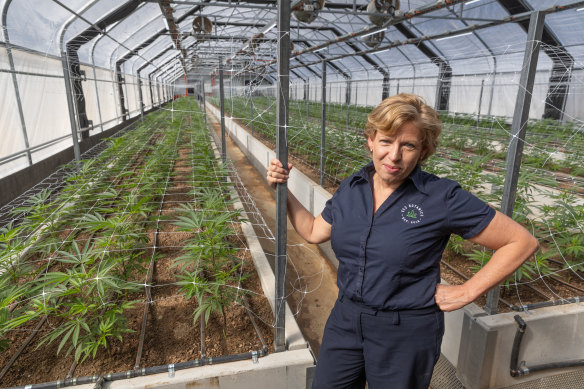- Exclusive
- National
- Legal Cannabis
This was published 9 months ago
As Canadian cannabis conquers Australia, local growers face tough rules
By Clay Lucas
Canada is exporting tonnes of cannabis into Australia with few checks on its quality, while Australian growers of the plant are forced to meet strict criteria before the product can be sold on the country’s booming medicinal market.
Canada does not allow the importation of cannabis, but last year the country exported 34 tonnes of high-THC strength cannabis into Australia.
Seventy per cent of the medicinal cannabis sold in Australia’s rapidly expanding legal market comes from Canada.
Medicinal cannabis is now worth about half-a-billion dollars in sales annually in Australia. The industry began with legalisation in 2016 but roared to life in 2020 when the pandemic popularised telehealth and Australians realised they could access the drug legally and easily for the first time.
Australians with a prescription for chronic pain, anxiety, sleep issues or a range of other reasons can now get medicinal cannabis for smoking, vaping or taking as an oil or gummies delivered via online cannabis clinics.

ECS Botanics managing director Nan-Maree Schoerie. Her medicinal cannabis farm is listed on the ASX and grows about six tonnes of medicinal cannabis this year.Credit: Jason South
An investigation into the nation’s medicinal cannabis sector has raised serious concerns about the level of regulation in the industry, particularly around telehealth, medical ethics and risks to consumers.
Alongside these issues is the increasing amount of Canadian cannabis coming into Australia. About six tonnes arrived in Australia in 2021, growing to 34 tonnes last year.
Australia is the top destination for Canadian cannabis, followed by Israel – which has launched an investigation into whether Canada is dumping cannabis into the country (Canadian companies say they are not).
Nan-Maree Schoerie, managing director of ECS Botanics, is a listed Australian cultivator and manufacturer of medicinal cannabis whose farm is on the Murray River in Victoria’s north-west.
ECS grows about six tonnes of high-quality, organic product each year. Located in an ideal climate – about 30 degrees and dry for much of the year – it allows the company to grow greenhouse and outdoor crops.
“We’ve had strong demand for our products,” Schoerie told The Age during a tour of her farm last month.
ECS exports to Britain, Germany and New Zealand, and grows for Australian businesses.
“Our success at the moment is really dependent on exports,” she said.
The company made about $20 million in sales last year, 31 per cent more than in 2022.
But Schoerie’s business, while still turning decent profits this year, is having to contend with a country awash with Canadian cannabis. She says there is plenty of good-quality Canadian cannabis coming into Australia, along with lower-quality product.
Canada legalised medicinal cannabis in 2001, and it later became legal for recreational purposes. To accommodate an expected boom, Canadian companies “raised billions of dollars, all on the basis that it would be this massive industry, and the more you grew the more money you could raise”, Schoerie said.
But there is now a glut of cannabis in Canada.
ECS exports 30 per cent of its cannabis. “Which is absolutely insane,” Schoerie said. “We are successful by exporting, but if we could export and supply the local market too, we would be double the size.
“I have no issue with imports coming here; the issue is that because they have surplus product, they’re dumping it here, which makes things difficult for local cultivators,” she said.
Schoerie said Australia’s manufacturing standards were very high.
“And our [manufacturing] post-harvest facilities are pristine – it’s like a hospital,” she said. “Canada doesn’t require [strict manufacturing rules], so they send their products here in bulk. It gets packed here, and [then] it gets designated as having been manufactured properly, and then they sell it. So Australia, unlike Europe, has this lower standard for imports – so we have become a honey pot, especially for Canada.”
Peter Koetsier, chair of Medicinal Cannabis Industry Australia and former chief executive of Mildura-based cultivator Cann Group, said Canadian cannabis imports were having a profound impact.
Much of what was imported was excellent quality, “but there’s a lot of that commodity type of behaviour going on in the marketplace and prices are coming down”, he said.
Canadian cannabis imports had “created this huge competitive force that has really sent local growers to the financial wall”.
Koetsier said Australia’s system of ensuring there was good manufacturing here ensured that locally grown cannabis was a high-quality pharmaceutical product. By comparison, Canadian products coming into Australia, while often of high quality, were barely checked at all.
“Local growers object to having to go through mandatory testing of all batches to the Therapeutic Goods Administration standard, but for the imported product there is an assumption that it’s tested in Canada. But no one is actually checking it.”
Approached for comment on whether Canadian cannabis was flooding Australia, Trade Minister Don Farrell’s office referred questions to the Department of Health. The department referred questions to agriculture authorities.
A spokeswoman for the Department of Agriculture, Fisheries and Forestry said the Australian government “has policies and programs in place to support a productive, competitive and sustainable agricultural sector. However, the success of individual products is subject to market conditions.”
Attempts to contact the Canadian Trade Ministry by deadline were unsuccessful.